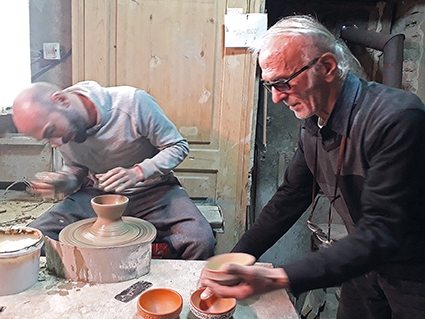Ceramic Revival: Mtskheta
Blog
Aside from having a name difficult for Westerners to pronounce, Mtskheta is known for being the capital of Georgia as it was from roughly 500 BC to 500 AD. This, then, would be the city where Christianity was adopted as the national religion early in the 4th century.
Given Georgia’s truly ancient status as a place of dwelling, however, it should not come as much of a surprise that things much older than 2500 years old might be found here. One of these would be pottery, one of the world’s earliest arts.
I recently caught up with my new Russian friends, who had just left our Svaneti guest house after two weeks of children’s clubs and pottery teaching, described in my last three GT articles. They, too, can now be found in Mtskheta. They have bought a house near the Shiomgvime Monastery just outside the city and are renting another place while they have this riverside one renovated.
The wife introduced me to a local potter whom she met. Eldar Mamaladze has had his current studio since 1994. He digs and refines his own clay from near Mtskheta, and has a wheel and two electric kilns, one small and one more than a cubic meter in volume, to fire work in. He also has a son, Giorgi, who in his mid-20s has been following dad’s footsteps in learning the art; a daughter who is very active in the city’s Council of Culture and Education; and a very supportive wife. Eldar, however, was the first in his family to get into ceramics, largely influenced by his mother, who was a painter. Pottery traditions might get handed down through the generations, but they have to start somewhere!
Father and son have a good collection of plaster molds for pressing or pouring multiple pieces which they then color with clay slips or glazes. They also throw vessels on the wheel, often incising or texturing them (this latter is a process secret to them) and then again adding color to the usually reddish earthenware. It fetches high prices, and should, because it is beautiful and refined. We were given wine to drink on the spot, after our tour of the facility, and then given the bowls we had used as a precious gift to treasure.
My Russian friend really wants to see pottery restored as an art in Mtskheta, and the art scene revitalized in general, especially among children, our future. She and her husband have found a building which locals claim was for a long time the center of this industry, although nothing now remains to testify of it at all except the structure itself. We walked around it and wondered how we might find out its true history and current ownership; is there anything there worth restoring, or should one start elsewhere in Mtskheta?
As I walked around this ancient city which I have not been in much for about a decade, seeing the changes and improvements made to it during this interval, I began to have hope that much of its infrastructure and culture could continue to receive new life here. It’s all so close to Tbilisi that a daily commute would not be hard at all, especially if one lived on the closer side of the current capital. Mtskheta offers the quieter, simpler advantages of small-city living while being close to the big action as well, if one wants this. So, I hail my friends’ desires to see the improvements continue and grow and look forward to what another decade of growth will bring.
Tony Hanmer has lived in Georgia since 1999, in Svaneti since 2007, and been a weekly writer for GT since early 2011. He runs the “Svaneti Renaissance” Facebook group, now with nearly 2000 members, at www.facebook.com/groups/SvanetiRenaissance/
He and his wife also run their own guest house in Etseri:
www.facebook.com/hanmer.house.svaneti
By Tony Hanmer












